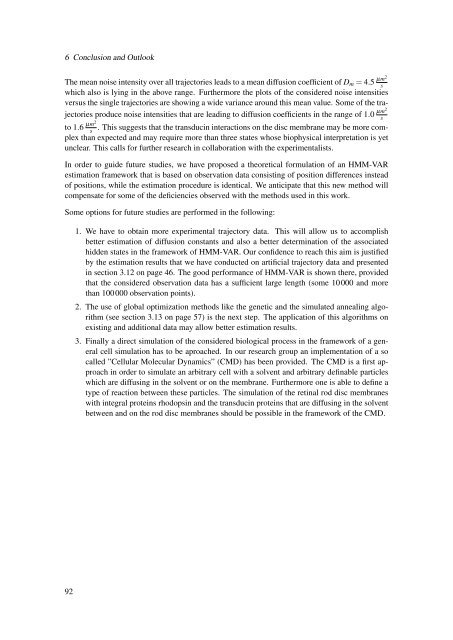Diffusion Processes with Hidden States from ... - FU Berlin, FB MI
Diffusion Processes with Hidden States from ... - FU Berlin, FB MI
Diffusion Processes with Hidden States from ... - FU Berlin, FB MI
Create successful ePaper yourself
Turn your PDF publications into a flip-book with our unique Google optimized e-Paper software.
6 Conclusion and OutlookThe mean noise intensity over all trajectories leads to a mean diffusion coefficient of D m = 4.5 µm2swhich also is lying in the above range. Furthermore the plots of the considered noise intensitiesversus the single trajectories are showing a wide variance around this mean value. Some of the trajectoriesproduce noise intensities that are leading to diffusion coefficients in the range of 1.0 µm2sto 1.6 µm2s. This suggests that the transducin interactions on the disc membrane may be more complexthan expected and may require more than three states whose biophysical interpretation is yetunclear. This calls for further research in collaboration <strong>with</strong> the experimentalists.In order to guide future studies, we have proposed a theoretical formulation of an HMM-VARestimation framework that is based on observation data consisting of position differences insteadof positions, while the estimation procedure is identical. We anticipate that this new method willcompensate for some of the deficiencies observed <strong>with</strong> the methods used in this work.Some options for future studies are performed in the following:1. We have to obtain more experimental trajectory data. This will allow us to accomplishbetter estimation of diffusion constants and also a better determination of the associatedhidden states in the framework of HMM-VAR. Our confidence to reach this aim is justifiedby the estimation results that we have conducted on artificial trajectory data and presentedin section 3.12 on page 46. The good performance of HMM-VAR is shown there, providedthat the considered observation data has a sufficient large length (some 10000 and morethan 100000 observation points).2. The use of global optimization methods like the genetic and the simulated annealing algorithm(see section 3.13 on page 57) is the next step. The application of this algorithms onexisting and additional data may allow better estimation results.3. Finally a direct simulation of the considered biological process in the framework of a generalcell simulation has to be aproached. In our research group an implementation of a socalled ”Cellular Molecular Dynamics” (CMD) has been provided. The CMD is a first approachin order to simulate an arbitrary cell <strong>with</strong> a solvent and arbitrary definable particleswhich are diffusing in the solvent or on the membrane. Furthermore one is able to define atype of reaction between these particles. The simulation of the retinal rod disc membranes<strong>with</strong> integral proteins rhodopsin and the transducin proteins that are diffusing in the solventbetween and on the rod disc membranes should be possible in the framework of the CMD.92









